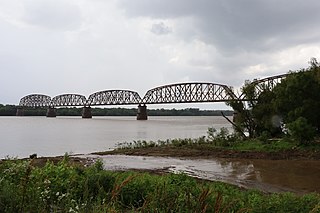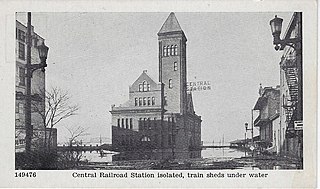The Cleveland, Cincinnati, Chicago and St. Louis Railway, also known as the Big Four Railroad and commonly abbreviated CCC&StL, was a railroad company in the Midwestern United States. It operated in affiliation with the New York Central system.

The Illinois Central Railroad, sometimes called the Main Line of Mid-America, was a railroad in the Central United States. Its primary routes connected Chicago, Illinois, with New Orleans, Louisiana, and Mobile, Alabama, and thus, the Great Lakes to the Gulf of Mexico. Another line connected Chicago west to Sioux City, Iowa (1870), while smaller branches reached Omaha, Nebraska (1899) from Fort Dodge, Iowa, and Sioux Falls, South Dakota (1877), from Cherokee, Iowa. The IC also ran service to Miami, Florida, on trackage owned by other railroads.

The Louisville and Nashville Railroad, commonly called the L&N, was a Class I railroad that operated freight and passenger services in the southeast United States.

The Union Station of Louisville, Kentucky is a historic railroad station that serves as offices for the Transit Authority of River City (TARC), as it has since mid-April 1980 after receiving a year-long restoration costing approximately $2 million. It was one of at least five union stations in Kentucky, amongst others located in Lexington, Covington, Paducah and Owensboro. It was one of three stations serving Louisville, the others being Central Station and Southern Railway Station. It superseded previous, smaller, railroad depots located in Louisville, most notably one located at Tenth and Maple in 1868–1869, and another L&N station built in 1858. The station was formally opened on September 7, 1891, by the Louisville and Nashville Railroad. There was a claim made at the time that it was the largest railroad station in the Southern United States, covering forty acres. The other major station in Louisville was Central Station, serving the Baltimore and Ohio, the Illinois Central and other railroads.
The Kentucky–Illinois–Tennessee League was a Class D level minor league baseball circuit that went through six different periods of play between 1903 and 1955. The League hosted teams in 29 cities from the states of Illinois, Indiana, Kentucky, Missouri and Tennessee.

The Metropolis Bridge is a railroad bridge which spans the Ohio River at Metropolis, Illinois. Originally built for the Chicago, Burlington and Quincy Railroad, construction began in 1914 under the direction of engineer Ralph Modjeski.

The Nashville, Chattanooga, and St. Louis Railway Office and Freight House, simply known as the Paducah Freight House, is a historic railroad freight depot located in the southern portion of downtown Paducah, Kentucky.
The following is a brief history of the North American rail system, mainly through major changes to Class I railroads, the largest class by operating revenue.
The following is a brief history of the North American rail system, mainly through major changes to Class I railroads, the largest class by operating revenue.
The following is a brief history of the North American rail system, mainly through major changes to Class I railroads, the largest class by operating revenue.

The Wabash Railroad was a Class I railroad that operated in the mid-central United States. It served a large area, including track in the states of Ohio, Indiana, Illinois, Iowa, Michigan, and Missouri and the province of Ontario. Its primary connections included Chicago, Illinois; Kansas City, Missouri; Detroit, Michigan; Buffalo, New York; St. Louis, Missouri; and Toledo, Ohio.
The Elizabethtown and Paducah Railroad was a 19th-century railway company in western Kentucky in the United States. It operated from 1867 to 1874, when it was purchased by the Louisville, Paducah and Southwestern Railroad. It later made up part of the Illinois Central network and its former rights-of-way currently form parts of the class-II Paducah and Louisville Railway.
The Louisville, Paducah and Southwestern Railroad was a 19th-century railway company in western Kentucky in the United States. It operated from 1874, when it purchased the Elizabethtown and Paducah, until 1876, when it was purchased by the Paducah and Elizabethtown. It later made up part of the Illinois Central network and its former rights-of-way currently form parts of the class-II Paducah and Louisville Railway.
The Paducah and Elizabethtown Railroad was a 19th-century railway company in western Kentucky in the United States. It operated from 1877, when it purchased the Louisville, Paducah and Southwestern Railroad, until 1882, when it was purchased by the Chesapeake, Ohio and Southwestern Railroad. It later made up part of the Illinois Central network and its former rights-of-way currently form parts of the class-II Paducah and Louisville Railway.

The Chesapeake, Ohio and Southwestern Railroad was a 19th-century railway company in Kentucky in the United States. It operated from 1882, when it purchased the Paducah and Elizabethtown Railroad and the Memphis, Paducah and Northern Railroad, until 1896, when it was purchased by the Chicago, St. Louis and New Orleans Railroad. It later made up part of the Illinois Central network and its former rights-of-way currently form parts of the class-II Paducah and Louisville Railway.
The Owensboro and Nashville Railroad was a 19th-century railway company in western Kentucky in the United States. It operated daily trains from its terminus in Owensboro to Louisville, Kentucky, and to points east and west.
The Owensboro and Nashville Railway was a 19th- and early-20th-century railway company in western Kentucky in the United States. It operated from 1881, when it purchased the defunct Owensboro & Nashville and Tennessee & Kentucky railroads, until 1921, when it was purchased by the L&N. Its former rights-of-way currently form parts of the class-I CSX Transportation railway.

Central Station was a major train station in Louisville, Kentucky. Built in the Richardsonian Romanesque style, it served several railroad companies until the mid-20th century. It was situated at North 7th Street and West River Road, near the Ohio River waterfront, and it was also known as the 7th Street Depot.







